After introducing the closed-course-only Ninja H2R and teasing us with enough one-minute videos to stock a basic-cable channel, Kawasaki Heavy Industries has at last announced the road-going Ninja H2. Fans of going fast won’t be disappointed: it has almost the same 300 horsepower supercharged powerplant as the H2R, as well as all the equipment needed to make the motorcycle fully road legal. But fans of going fast inexpensively may be in for a little bit of a letdown: the H2 is $25,000 and will only be available to a select few lucky buyers.
Kawasaki’s press release for the H2 contains a lot more information than the one released at INTERMOT for the H2R. We find out that in addition to the compact, light trellis frame (tuned for controlled flex) and single-sided swingarm (the first on a Kawasaki), the H2 uses an inverted 43mm KYB AOS Air-Oil Separate fork, also a first for a Kawasaki street model. Brakes are four-piston monobloc Brembo calipers and 330mm discs. It’s fully loaded with all the electronics you’d expect for 25 gees: switchable KTRC traction control with nine rider-selectable levels. Yes, you can turn it off, just in case you want to highside yourself back to the Julian calendar. There’s also a quick shifter, switchable ABS, launch control, engine-braking control and an Öhlins electronic steering damper.
There’s no mention of horsepower in the release, but expect less than the H2R. How much less? Who knows, but it’ll still probably be far more than any sane person could ever use or even need on public byways. The 130,000-rpm supercharger develops up to 20.5 PSI of boost pressure (about the same as Porsche’s 552-hp 911 Turbo), and Kawasaki says that other than “camshafts, head gaskets and clutch, the engine is the same as the unit found in the Ninja H2R.” The exhaust system is also different to meet noise and emissions regulations. I’m going to guess 240-250 hp at the crank and over 200 at the rear wheel.
Crazed power output aside, this isn’t really a racer-with-lights. It’s a halo model, an aspirational, look-at-me ultimate street ride to rival GT models like the Suzuki Hayabusa or Kawasaki’s own ZX-14R (I thought this would be a mass-model replacement for the big Zed, but the ZX-14R continues for 2015). At almost 525 pounds wet (claimed) it will be a handful (but fun!) for trackdays, and Kawasaki claims the seating position will be slightly more comfy than a ZX-10R. The instrumentation is comprehensive, with a large white-on-black LCD screen. There is no passenger seat or footpegs—aside from full LCD lighting, the fairing is similar to the H2R, complete with the hand-applied mirror-like black paint.
Kawasaki’s Ninja H2 isn’t the superlight sportbike we expected, but it’s a pretty special motorcycle all the same. You can get one by getting your order in with your Kawasaki dealer by December 19th. But there’s still one more burning question: will MD get to ride one?
Here is the official press release from Kawasaki regarding the new Ninja H2:
The launching point for the development of the Ninja H2™ motorcycle was a strong desire to offer riders something they had never experienced before. Convinced that an extraordinary riding experience would not be found by merely building on the performance of existing models, the design team committed to developing the “ultimate motorcycle” from a clean slate.
The bike needed to deliver intense acceleration and ultra-high top speed, coupled with supersport-level circuit performance. To realize this goal, help was enlisted from other companies within the Kawasaki Heavy Industries, Ltd (KHI) group, precipitating an unprecedented level of collaboration.
Ninja H2 development pursued two paths. The first was the Ninja H2™R, which is a closed-course model that allowed the unadulterated pursuit of performance without the limitations of street homologation. This motorcycle is followed by the Ninja H2 street model, which is based closely on the H2R but meets all market regulations. The results are incredible, with both models offering a sensory experience surpassing anything else that riders can find today.
A supercharged engine closely based on the same powerplant as the Ninja H2R powers the Ninja H2. High output notwithstanding, the compact design is on par with power units found in supersport liter-class models. The key to achieving this incredible performance lies in the supercharger – a motorcycle-specific unit designed completely in-house with technology from the Gas Turbine & Machinery Company, Aerospace Company and Corporate Technology Division.
HIGHLIGHTS OF THE 2015 KAWASAKI NINJA H2™:
- Street model based on closed-circuit Ninja H2R
- 998cc four-cylinder engine fitted with Kawasaki supercharger for intense acceleration
- Supercharger uses planetary gears, spins at up to 130,000rpm and develops up to 20.5psi boost pressure
- Dog-ring transmission allows fast shifting and works with standard quick shifter
- Bodywork developed with Kawasaki Aerospace Company to generate downforce
- Kawasaki River Mark used to indicate combined Kawasaki Group technology
- Trellis frame used for first time to provide strength, controlled flex and air circulation
- Single-sided swingarm used for first time, mounted to engine as a stressed member
- KYB® AOS-II Air-Oil Separate cartridge fork, adjustable KYB rear shock
- 330mm front discs with four-piston Brembo® calipers
- Multi-mode traction control, launch control, engine braking control, ABS and a quick shifter
KHI Group’s technology was not limited to the supercharger. Advanced technological know-how shared from other Group companies is found throughout the innovative engine and chassis design. For example, the aerodynamic mirror mounts were designed with assistance from Kawasaki’s Aerospace Company to add stability for high-speed riding. This highlights the collaboration, and the level of technology poured into the model was the reason the Kawasaki River Mark* is prominently displayed on the upper cowl.
When it came time to name this model, “Ninja®” was an obvious choice because it is synonymous with Kawasaki performance, and is shared by legendary models over the years. It is also named for another iconic model: the “H2” (also known as the 750SS Mach IV in some markets), which was powered by a two-stroke 748cc triple and boasted the sort of intense acceleration that made it a worldwide sensation. For a motorcycle that delivers supersport-level handling coupled with the kind of acceleration no rider has experienced before, Ninja H2 was the perfect name. And so Kawasaki is again ready to unleash a new sensation upon the world.
*The Kawasaki River Mark is a long-time symbol of KHI dating back to the 1870s. As a policy, its use on products is limited to models with historical significance. But permission was granted for the Ninja H2 to use this special symbol.
THE QUEST FOR POWER
In order to offer intense acceleration, it was essential that the engine was able to produce big power. While a large-displacement engine could easily provide high output, the engineers preferred it to be compact to help ensure a lightweight, compact motorcycle.
Using a supercharged engine enabled these engine design requirements to be met. Aside from minor differences in the engine, as well as an intake and exhaust system tailored for street use to meet noise and emissions standards, the supercharged engine is essentially the same as the closed-course Ninja H2R. It delivers intense acceleration unlike anything you can experience on a naturally aspirated bike. Designed in-house, the immense potential of the compact, highly efficient engine is a testament to the technology possessed by the KHI Group.
SUPERCHARGED 998cc IN-LINE FOUR
KHI-DESIGNED SUPERCHARGER
The supercharger used by the Ninja H2 was designed by Kawasaki motorcycle engineers with assistance from other companies within the KHI Group, namely the Gas Turbine & Machinery Company, Aerospace Company, and Corporate Technology Division. Designing the supercharger completely in-house allowed it to be developed to perfectly match the engine characteristics of the Ninja H2. The highly efficient, motorcycle-specific supercharger was the key to achieving the maximum power and intense acceleration the engineers wanted.
- One of the greatest benefits of designing the supercharger in-house and tailoring its design to match the character of the Ninja H2 engine was that engineers were able to achieve high-efficiency over a wide range of conditions – something that would not have been possible by simply using an aftermarket automotive supercharger.
- The importance of high efficiency in a supercharger is so that, as air is compressed, power-robbing heat gain is minimal. And while many superchargers are able to offer high-efficiency operation in a limited range of conditions, the KHI-designed supercharger for the Ninja H2 offers high efficiency over a wide range of pressure ratios and flow rates – so it is over a wide range of engine- and vehicle speeds. This wide range of efficient operation (similar to having a wide powerband) translates into strong acceleration.
- The supercharger’s high efficiency and minimal heat gain meant an intercooler was unnecessary, allowing savings in both weight and space.
- The supercharger is a centrifugal-type unit – ideal for high-RPM performance – with a cast aluminium housing.
- The unit is located centrally, behind the cylinder bank, in the best position to evenly distribute compressed air to all four cylinders.
- The supercharger uses engine oil for lubrication. By not requiring an independent oil source, it contributed to the compact, lightweight design.
- The supercharger is driven by a planetary gear train, which runs off the crankshaft. Designing the gear train using technology from Kawasaki’s Aerospace Company resulted in a compact unit with minimal power loss.
- The gear train increases the impeller speed up to 9.2x the crank speed (1.15x step gear with an 8x planetary gear). This means at a maximum engine speed of approximately 14,000rpm, the impeller shaft is spinning at almost 130,000rpm.
- The impeller is formed from a forged aluminium block using a 5-axis CNC machine to help ensure precision and durability. The 69mm impeller features six blades at the tip, expanding to 12 blades at the base. Grooves etched into the blade surfaces help direct the airflow.
- The impeller’s pumping capacity is more than 200 liters/second (measured at atmospheric pressure), with intake air reaching speeds of up to 100m/s. After passing through the supercharger, air pressure is increased to as much as 2.4x atmospheric pressure (35psi).
POWER UNIT DESIGNED FROM THE CLOSED-COURSE NINJA H2R
Despite its familiar in-line four configuration, the Ninja H2 engine is loaded with technology developed specifically for this supercharged engine: some new, others with know-how from the Kawasaki Group.
Every component of the engine was chosen to achieve a certain function. In order to accommodate the higher air pressure from the supercharger, as well as to help ensure reliability of the closed-course Ninja H2R, the entire engine was designed to be able to handle stresses 1.5-2x greater than a naturally aspirated liter-class engine. In fact, aside from its camshafts, head gaskets and clutch, the engine is the same as the unit found in the Ninja H2R.
- The combustion chamber design is complemented by flat piston crowns. The shape, inspired by the pistons used in the Green® Gas Engine developed by Kawasaki’s Gas Turbine & Machinery Company, also contributes to the engine’s anti-knock performance.
- While the intake valves are stainless steel, the exhaust valves needed to be able to withstand the supercharged engine’s high-temperature exhaust gases. So the exhaust valves are formed from two materials that are friction-welded at the center: Inconel – an extremely heat-resistant alloy – is used for the valve head and lower half of the stem; while heat-resistant steel is used for the upper half. The stems are tapered, varying in diameter from 4.5-5mm.
- A dummy head is used during the cylinder honing process. The more precise circular and cylindrical shape that results allows the use of low-tension piston rings, which help reduce mechanical loss.
- The pistons are cast, since they offer better strength than forged pistons under the very high temperatures generated by the high-performance supercharged engine. A unique casting process (similar to forging) sees unnecessary material removed, with hollows created to achieve the ideal thickness. This produces a piston weight on par with forged pistons.
DOG-RING TRANSMISSION
To facilitate smooth, quick shifting, a dog-ring-type transmission was selected. This is similar to the kind of transmission commonly found in MotoGP™ or Formula 1®, and was developed with feedback from the Kawasaki Racing Team.
- Unlike a standard motorcycle transmission, where the shift forks slide the gears into position, the gears remain in place in a dog-ring transmission. Only the dog rings move, sliding into position to engage the desired gear.
- Because the dog rings are lighter than transmission gears, this type of transmission offers a significantly lighter shift effort. Shift feel is also improved, and a much quicker shift is possible, facilitating quicker acceleration.
HYDRAULIC CLUTCH & BACK-TORQUE LIMITER
A high-quality hydraulic clutch offers less maintenance and helps to ensure that the initial bite point can be maintained. By using Brembo® components, superb linearity and smooth actuation are further benefits.
- Brembo parts are used for both the clutch lever’s radial-pump master cylinder and the clutch release mechanism. They receive extra attention from Brembo before being shipped to Kawasaki. Each part is examined and adjusted to help eliminate any ineffective (idle) stroke, resulting in superb control.
- The back-torque limiter contributes to stability by helping prevent wheel hop when downshifting. The back-torque limiter is also adjustable.
MAXIMIZING AIRFLOW EFFICIENCY
To maximize the performance of the supercharged engine, airflow efficiency was of paramount importance. How air enters the supercharger, how the compressed air enters the engine, and how the combusted air/fuel mixture is discharged were all carefully analyzed for maximum efficiency to help ensure the airflow characteristics would create the desired engine character.
RAM AIR INTAKE
- Air supplied to the supercharger enters via a single ram air intake in the left side of the upper cowl. The total frontal area is approximately 3x the area of the supercharger inlet.
- A ram air duct was designed to take the fresh air to the supercharger in as straight a line as possible. Its shape was created to match the impeller characteristics, further contributing to the engine’s output.
- For optimum efficiency for the Ninja H2 engine, the air cleaner is positioned directly in front of the supercharger.
ALUMINIUM INTAKE CHAMBER
- The intake chamber has a large volume (6 liters), and is ideally shaped for high efficiency and engine output.
- Being constructed from rigid aluminium offers two advantages:
1) Aluminium offers excellent surface heat dissipation, helping to keep the intake air cool;
2) The rigid structure helps to ensure an airtight seal for the pressurized air at approximately 2-bar (29.4psi). - Inside the intake chamber, newly developed Kawasaki technology contributes to the engine’s high performance. The top injectors spray fuel onto stainless steel mesh positioned over the intake funnels. This has an ordering effect, creating a more uniform air/fuel mixture as the fuel is drawn into the intake funnel. The mesh also promotes fuel misting, which helps cool the intake air and increases combustion chamber efficiency.
ELECTRONIC THROTTLE VALVES
Kawasaki’s fully electronic throttle actuation system enables the ECU to control the volume of fuel (via fuel injectors) and air (via throttle valves) delivered to the engine. Ideal fuel injection and throttle valve position results in smooth, natural engine response and the ideal engine output. The system also makes a significant contribution to reduced emissions.*
* The system enables more precise control of KTRC (Kawasaki Traction Control), and facilitates implementation of other electronic systems like KLCM (Kawasaki Launch Control Mode) and Kawasaki Engine Braking Control – see below.
INTAKE & EXHAUST PORTS, CAMSHAFT PROFILES
- The intake ports are polished to help ensure smooth air/fuel flow and minimize resistance.
- Straight exhaust ports – one for each exhaust valve – do not converge in the cylinder head. The straight-line design enables the most efficient removal of air from the combustion chamber and also contributes to efficient combustion chamber filling.
- Camshaft profiles were optimized for the Ninja H2 engine and are tuned to offer strong low-speed torque.
EXHAUST SYSTEM
- The entrance to the header pipes is oval to match the two exhaust ports per cylinder. Partly formed by hydroforming, each header pipe tapers from an oval to a round cross-section. The collector pipes are also hydroformed.
- Designed to suit the output and characteristics of the Ninja H2 engine, the stainless steel header pipes have a 45mm diameter. For the ideal exhaust pressure, all four header pipes are connected.
- The exhaust system also includes a compact under-engine pre-chamber, with double-wall construction for rigidity. This construction helps reduce radiating noise and high frequency exhaust noise.
- The single right-side silencer ensures noise and exhaust gas emissions meet market regulations.
KEEPING THE ENGINE COOL
Cooling performance can be a substantial limiting factor for engine output, so maximizing the cooling efficiency was a key consideration when designing the engine. In addition to helping ensure that intake air remain as cool as possible, the heat generated by the high-output engine needs to be dissipated, and engine components themselves need to be kept cool to help ensure efficient operation. The extensive pursuit of cooling performance led to a highly complex engine layout, both for the lubrication system (oil is used for cooling as well as lubrication) and the cooling system.
CYLINDER HEAD
A number of considerations were given to the aluminum cylinder head design to provide the necessary cooling performance. The large coolant passageways result in excellent cooling for the combustion chamber.
- The water jacket extends between the twin exhaust ports of each cylinder, while large coolant passageways around the spark plug holes and valve seat areas offer superior cooling. The steel spark plugs and valve seats have a greater tendency to retain heat than the aluminum cylinder head, so cooling them is very important and makes a big difference to temperature control.
In the interest of keeping the engine compact and simple, a single lubrication system provides cooling oil for the engine components, supercharger and the transmission.
- Oil jets lubricate the supercharger chain in two places – at the contact points where the chain meets the upper and lower sprockets.
- In addition to the two oil jets, the supercharger drivetrain’s lower gear has an oil passage.
- Inside the engine, there are two oil jets per cylinder to ensure the hot pistons are effectively cooled.
- Transmission oil jets (used for the first time in a Kawasaki motorcycle) enable a compact transmission with high durability.
LUBRICATION SYSTEM COMPONENTS
Because the lubrication system is servicing so many components, oil volume is 5.0 liters (1.3 gallons) – that is about 35% more than usually seen in a naturally aspirated engine of the same displacement.
RADIATOR
- The radiator’s size and capacity is on par with those found on current liter-class supersport motorcycles, but it offers superior cooling performance because it flows approximately 1.5x more air than other bikes. This was found to be more effective than simply increasing the size of the radiator.
- Airflow is facilitated by the compact side-cowl design, and leaving the lower part of the engine open (except for the small under cowls) to the air was designed to extract hot air.
LIQUID-COOLED OIL COOLER
- A liquid-cooled oil cooler adds to the extremely high cooling performance necessary for the high output engine.
HIGH-SPEED STABILITY & LIGHT HANDLING
Designed for the performance parameters of the closed-course Ninja H2R and shared with the street-going Ninja H2, the objectives for the chassis were to provide superb motorcycle composure at ultra-high speeds, while offer cornering performance that allows the rider to enjoy riding on a circuit, and finally to be very accommodating to the rider. Ordinarily, high-speed stability can easily be achieved with a long wheelbase, but a shorter wheelbase was selected to achieve the compact overall package and sharp handling that were desired. So the frame needed to not only be stiff, but also to be able to absorb external disturbances, which could otherwise unsettle the chassis when encountered at high speed. A trellis frame provided both the strength to harness the incredible power of the supercharged engine, and the balanced flex to achieve stability for high-speed riding.
INNOVATIVE CHASSIS DESIGN
TRELLIS FRAME
Using a trellis frame offered an elegant, lightweight solution to meeting the performance requirements for the chassis of the closed-course Ninja H2R. Able to harness the massive power of its engine, it has a balance of stiffness and flexibility that enables a high level of stability while being able to handle external disturbances at high speeds. Its open design also helps dissipate heat generated by the supercharged engine.
- Development of the trellis frame made good use of the latest analysis technology and substantial test rider feedback.
- Pipe diameter, thickness and the bend of each piece of the trellis frame were carefully selected to obtain the necessary stiffness for each part of the frame. The trellis pieces are primarily made from high-tensile steel.
SWINGARM MOUNTING PLATE
This innovative new chassis mechanism allows the engine to act as part of the frame.
- The swingarm mounting plate bolts to the back of the engine. The swingarm pivot shaft goes through this plate, essentially allowing the swingarm to be mounted directly to the engine.
- Thanks to the swingarm mounting plate, the frame does not need to use crossmembers for stability. This contributes to the frame’s low weight.
SINGLE-SIDED SWINGARM
The Ninja H2 and H2R feature Kawasaki’s first single-sided swingarm.
- Having a single-sided swingarm allows the exhaust silencer to be mounted closer to the bike centerline, providing a high bank angle for sporty cornering.
CHASSIS GEOMETRY
To ensure fun at high speeds as well as on the racing circuit, a compact package was desired. Therefore, the chassis geometry is very similar to that of a liter-class supersport motorcycle.
FRONT SUSPENSION
KYB® AOS-II racing suspension makes its debut on a street bike.
- Based on the Air-Oil Separate cartridge fork that was developed for motocross racing.
- Designed for low friction, the 43mm front fork offers superb action, with a smooth initial action followed by strong damping at the end of the stroke.
- As the suspension works, a large 32mm free-floating piston at the bottom of the oil-damping cartridge pumps oil up to a sealed area between the inner and outer tubes. The oil in this area provides a friction-reducing film on which the tubes can slide against each other, resulting in an extremely smooth action.
REAR SUSPENSION
Fully adjustable KYB rear suspension offers superb stability.
- The top of the rear shock mounts to the swingarm mounting plate. Again, doing away with the need for frame crossmembers.
- The bottom of the rear shock is mounted via a revised Uni-Trak® linkage that offers excellent feedback for rear tire grip. The new linkage, situated below the swingarm, also mounts to the swingarm mounting plate.
BRAKES
Given the high-speed potential of the Ninja H2, the brakes chosen were the best available for a production motorcycle. Special tuning helped ensure that all play in the lever was removed from the system, so that when the brakes are applied they respond immediately.
- A pair of massive 330mm Brembo semi-floating discs, with a thickness of 5.5mm, delivers superb braking force.
- The brake discs have grooves running down the center of the outer edge to increase the discs’ surface area for greater heat dissipation.
- Dual radial-mount Brembo cast aluminum monobloc calipers grip the front discs. The rigid, opposed four-piston calipers with 30mm pistons contribute to the superb braking force of the Ninja H2, as well as a high-quality image.
- A Brembo radial-pump master cylinder and reservoir receive extra attention before being shipped to Kawasaki. Each part is examined and adjusted to help eliminate any play in the lever stroke.
- A large 250mm disc generates strong braking force at the rear.
ORIGINAL WHEEL DESIGN
The cast aluminum wheels were designed specifically for the Ninja H2 and H2R.
- The star-pattern five-spoke wheel design was selected based on the optimum balance of rigidity for high-speed performance.
- The analysis technology used in the wheel development comes from Kawasaki’s World Superbike involvement.
- Knurling on the inside of the rear wheel rim helps prevent tire slipping on the wheel that could be caused by the massive torque generated by the engine.
HIGH-SPEED TIRES
To help ensure sufficient tire durability when riding at high speed, high-performance tires must be used.
- A massive 200mm rear tire transmits the Ninja H2’s power to the tarmac.
- The Ninja H2 is able to use high-performance street tires.
SHAPED FOR SPEED
As speed increases, wind resistance increases exponentially. To enable high-speed operation, a combination of high power and slippery aerodynamics was needed. With power requirements taken care of by the supercharged engine, the next step was to design bodywork that provides both minimal drag and good control when riding at high speed. Assistance from Kawasaki’s Aerospace Company was enlisted in creating the aerodynamically sculpted bodywork to provide maximum aerodynamic efficiency.
AERODYNAMICS
AERODYNAMICALLY DESIGNED BODYWORK
It is no accident that when viewed from the side, the Ninja H2 and H2R do not have the aggressive forward-canted stance of most modern supersport motorcycles. While supersport bikes use their front-leaning attitude to aid quick steering, at the speeds for which the closed-course Ninja H2R was designed, such a posture would create drag, which would hinder top speed potential. Therefore, the H2 stance is very neutral, almost flat – like a Formula 1 car – to make the body as aerodynamically sleek as possible.
- The aerodynamically shaped upper cowl uses lips and lines to direct airflow over its surface.
- The upper cowl locates the ram air intake in the most efficient position.
- Compact side cowls and under cowls were designed to assist heat dissipation.
- The rear cowl has an extremely compact three-piece design. The center portion is taller, creating an aerodynamic form that helps smooth airflow as it passes the rider. Wind is also able to pass between the center and side pieces, further reducing air resistance.
GENERATING DOWNFORCE
In order to maintain both straight-line stability and the ability to change direction while running at high speed, the Ninja H2 features a number of aerodynamic devices to help ensure the front wheel has strong contact with the ground.
- The design of the upper cowl incorporates a chin spoiler. Rather than being a cosmetic flourish, it produces downforce that contributes to high-speed stability.
- Further contributing to high-speed stability, the Ninja H2 features mirror mounts with airfoil cross-sections. Like the wings on the closed-course Ninja H2R, the mounts were also designed by Kawasaki’s Aerospace Company. The trailing edges are equipped with Gurney flaps that increase the effectiveness of the simple airfoil shape, allowing greater downforce to be generated by the small surface.
MAN / MACHINE INTERFACE
Since the Ninja H2 was not intended to be a pure race bike, it did not need the spartan accommodations found on most purpose-built supersport models. As a result, the Ninja H2’s man / machine interface enables riders to enjoy the bike’s performance with a degree of comfort. While the riding position, ergonomics and cockpit layout were designed first and foremost to put the rider in the best position to control this amazing machine, the impression from the rider’s perspective is not one of austerity, but is more about quality, high-tech control and the impeccable fit and finish.
SEATING FOR ONE
RIDING POSITION & ERGONOMICS
With the kind of riding the Ninja H2 was designed for, and a desire for a compact package resulted in a riding position similar to that of a supersport bike without being quite as aggressive. As enjoyment of the intense acceleration and high-speed capability was the first priority, a solo seat for the rider is the only seating provided.
- The riding position was designed for high speed and circuit riding. The rider triangle is similar to that of the Ninja® ZX™-10R motorcycle, but more relaxed.
- To help support the rider during intense acceleration, hip-supporting pads flank the rear of the seat. The hip support is adjustable 15mm backward to suit the rider’s size.
INSTRUMENTATION & CONTROLS
The advanced, high-tech design of the instrumentation conveys the image of piloting a fighter jet. Handlebar control switches put all mode selection and display options at the rider’s fingertips.
- The new instrumentation design combines a full digital LCD screen with an analog-style tachometer.
- The LCD screen uses a black / white reverse display (white characters on a black background), contributing to the high-quality image.
- In addition to the digital speedometer and gear position indicator, display functions include: odometer, dual trip meters, current mileage, average mileage, fuel consumption, coolant temperature, boost indicator, boost (intake air chamber) temperature, stopwatch (lap timer), clock and the Economical Riding Indicator.
- The tachometer design uses an actual needle, but the black dial “face” looks blank until engine speed increases. Backlit RPM numbers light up to chase the tachometer needle as it moves around the dial.
- Compact new switch design allows all instrument functions to be controlled from the handles.
ELECTRONIC RIDER SUPPORT
Complementing the Ninja H2’s incredible engine and chassis performance, advanced electronics work behind the scenes to provide rider support. Depending on rider preference, many of the systems may be turned off. And while the high-performance engine was designed to be accommodating even without the benefit of rider aids, when electing to fully experience the Ninja H2’s intense acceleration or high-speed potential, these systems are available to provide an extra degree of rider confidence.
ENGINE & CHASSIS MANAGEMENT SYSTEMS
KTRC (KAWASAKI TRACTION CONTROL)
The new KTRC system used on the Ninja H2 combines the best elements of Kawasaki’s earlier traction control systems. Multi-level modes offer riders a greater number of settings to choose from, with each mode providing a different level of intrusion to suit riding conditions and rider preference. And all modes are designed to manage output when sudden wheel slip occurs. The new system offers both enhanced sport riding performance and the peace of mind to negotiate slippery surfaces with confidence.
- Riders can choose from three modes, each offering a progressively greater level of intrusion. Each of these modes also has three rider-selectable levels, adding more or less intrusion (rider preferences for each mode are programmable for on-the-move selection), giving a total of nine possible settings. Riders may also elect to turn the system off.
- Mode 1 is for the circuit, Mode 2 for the street, and Mode 3 for wet pavement conditions. A Rain Mode is also available, as outlined below.
- Using complex analysis, the system is able to predict when traction conditions are about to become unfavorable. By acting before slippage exceeds the range for optimum traction, it means that drops in power can be minimized, resulting in smoother operation.
- Rain Mode can be turned on and off independently from KTRC. Activating Rain Mode sets KTRC to Mode 3+, and limits power output, torque and response. Similar to a Low Power setting, maximum engine output is less than 50% of full power, with a gentler throttle response.
KLCM (KAWASAKI LAUNCH CONTROL MODE)
Designed to assist the rider by optimizing acceleration from a stop, KLCM electronically controls engine output to prevent wheelspin and minimize wheelies when launching.
- Riders can choose from three modes, each offering a progressively greater level of intrusion. Each mode allows the rider to launch from a stop with the throttle held wide open.
KAWASAKI ENGINE BRAKE CONTROL
The system allows riders to select the amount of engine braking they prefer.
- When the system is activated (by selecting “LIGHT” in the Engine Braking settings), the engine braking effect is reduced, providing less interference when riding on the circuit.
KIBS (KAWASAKI INTELLIGENT ANTI-LOCK BRAKE SYSTEM)
Kawasaki’s supersport-style ABS is standard equipment on the Ninja H2. This is based on the same system used on the Ninja ZX-10R, with programming and settings revised to suit the performance parameters of the Ninja H2.
- High-precision brake pressure control enables the system to avoid reduced brake performance due to excessive pressure drops, allows lever feel to be maintained when KIBS is active, and helps ensure ABS pulses feel smooth (not heavy).
- High-precision brake pressure control also offers a number of sport riding benefits:
Rear lift suppression
2. Minimal kickback during operation
3. Accounts for back-torque
KQS (KAWASAKI QUICK SHIFTER)
Ninja H2 is the first Kawasaki motorcycle to be fitted with a standard quick shifter.
- Complementing the engine’s strong power and the dog-ring transmission, a contactless-type quick shifter enables rapid upshifts for seamless acceleration.
ÖHLINS ELECTRONIC STEERING DAMPER
Unlike a mechanical steering damper – in which the settings, once fixed, must cover all riding conditions and speeds – the damping characteristics are changed electronically, according to vehicle speed, and the degree of acceleration or deceleration.
At low speeds, the settings were chosen so that damping does not interfere with the bike’s intrinsic lightweight handling. At high speeds, damping increases to provide enhanced stability.
- Kawasaki’s electronic steering damper was developed with Öhlins, one of the most popular and respected steering damper manufacturers.
- The electronic steering damper provides just the right amount of damping based on what the bike is doing. Using input from the rear wheel speed sensor (provided via the engine ECU), the electronic steering damper’s ECU determines the vehicle speed as well as the degree the bike is accelerating or decelerating.
STYLING & CRAFTSMANSHIP
Wanting to ensure a bold design worthy of a model that carries both the “Ninja” and “H2” names, the prime styling concept for the Ninja H2 was “Intense Force” design. As a flagship for the Kawasaki brand, it needs to have presence, and styling that reflects its incredible performance. But the design is much more than cosmetic. While its edged styling certainly looks the part, the Ninja H2 also possesses a functional beauty: each piece of its bodywork was aerodynamically sculpted to enhance high speed stability; the cowling design also maximizes cooling performance and heat dissipation, aiding the engine’s incredible output; and the ram air duct is ideally positioned to bring fresh air to the supercharger.
More than any Kawasaki motorcycle to date, the Ninja H2 is a showcase of craftsmanship, build quality and superb fit and finish – right down to the high-tech mirror-like paint specially developed for this model.
INTENSE FORCE DESIGN
STYLING & CRAFTSMANSHIP DETAILS
- Machined surfaces on the wheel spokes and painted rims contribute to a high-quality finish.
- High-level attention to detail is evident in the numerous machined fastener designs (such as the steering stem and rear hub nuts).
- Welding bead quality for the trellis frame is uniformly high, contributing to the Ninja H2’s superb fit and finish. Depending on the weld, some are efficiently and precisely welded by Kawasaki robots, while others are welded by expert Kawasaki craftsmen.
LIGHTING EQUIPMENT
Ninja H2 is equipped with all the lights needed for street-legal operation. And with the exception of the bulb illuminating the license plate, all lighting equipment on the Ninja H2 uses LEDs.
- The bright, compact LED headlamp is positioned low, at the front of the upper cowl, contributing to the “Intense Force” design.
- The design of the LED front position lamps brings to mind the fangs of a predator.
- The elegant LED tail light is flanked by surface-emitting LED position lamps.
- New LED rear turn signals designs feature an inner lens, surface texturing and surface-emitting LEDs that contribute to the bike’s high-quality image.
HIGH-TECH PAINT
The Kawasaki original silver mirror-like paint used on the Ninja H2 – known as Mirror Coated Black – was developed by Kawasaki specifically for motorcycles. The highly reflective surface adds to the bike’s stunning design.
- In the shade, the paint appears black, but once in the sunlight its highly reflective surface takes on the appearance of the surrounding scenery. The stark difference in the way the paint appears in the light and shade emphasizes the beautiful curvature of the bike’s sculpted bodywork.
- While this kind of paint is similar in appearance to what has been used by top custom builders, this is the first time it has been used on a mass-production vehicle in either the automotive or motorcycle industries. Strict Kawasaki quality control measures help to ensure a long-lasting finish.
- The highly reflective surface is created by inducing a silver mirror-like reaction (a chemical reaction between a solution of silver ions and a reducing agent) that forms a layer of silver. This silver (Ag) layer is what creates the paint’s glass-like metal appearance. Compared to candy paints, which use aluminum flakes to generate a sparkling effect, the Ag layer appears as a uniform metallic surface.
- In the shade the Ag layer is translucent, allowing the base coat color to show through. This gives the paint a deep, three-dimensional quality.
- While the multiple layers of paint on typical production vehicles are applied by robot painters, each layer of the paint on the Ninja H2 – from primer to clearcoat – is carefully finished by hand by Kawasaki craftsmen to ensure a flawless, lustrous surface. Twice the layers of clearcoat (two on standard pieces, four on pieces with decals) adds to the high-quality finish.
- The paint on the fuel tank is finished with a UV coat (the only layer where robot painters are used) to protect the tank’s brilliant finish.
KAWASAKI RIVER MARK
Special permission was obtained to use the River Mark on the Ninja H2. Its use is reserved for models of historical significance.
HIGH-PRECISION PRODUCTION
Unlike a regular mass-production model, the high-precision production of the Ninja H2 requires greater hands-on participation by skilled Kawasaki craftsmen. So each step, from metalworking, treatment, welding and painting to assembly, fine-tuning and inspection is carefully attended to create a product of superior quality. Within Kawasaki’s Akashi Factory, production takes place in an area dedicated exclusively to the Ninja H2 motorcycle.
COLOR
The Kawasaki Ninja H2 is only available in its very special Mirror Coated Black paint.
ORDERING INFORMATION
The Kawasaki Ninja H2R and H2 are limited-release production motorcycles, available for a short time in select markets. In order to reserve one of the world’s first supercharged production streetbikes, make a deposit at your local authorized Kawasaki dealer no later than December 19, 2014. Reservations will be taken on a first-come, first-served basis and are secured only with a deposit.
2015 Kawasaki Ninja H2™ Specifications*
| SPORTBIKES SPEC TEMPLATE | Ninja H2 |
| Engine | Liquid-cooled, 4-stroke in-line four |
| Displacement | 998cc |
| Bore x Stroke | 76 x 55mm |
| Compression Ratio | 8.5:1 |
| Fuel System | Fuel injection: 50mm x 4 with dual injection |
| Intake System | Kawasaki supercharger |
| Cooling System | Water-cooled |
| Lubrication | Forced lubrication, wet sump with oil cooler |
| Ignition | Digital |
| Transmission | 6-speed, return, dog-ring |
| Final Drive | Chain |
| Frame Type | Trellis, high-tensile steel, with swingarm mounting plate |
| Rake/Trail | 24.4˚ / 4″ |
| Fuel Capacity | 4.5 gallons |
| Front Suspension / Wheel Travel | 43mm inverted fork with rebound and compression damping, spring preload adjustability and top-out springs / 4.7 |
| Rear Suspension / Wheel Travel | New Uni-Trak® with gas-charged shock, piggyback reservoir, dual-range (high/low-speed) compression damping, rebound damping and preload adjustability, and top-out spring / 5.3″ |
| Front Tire Size | 120/70 ZR17 M/C (58W) |
| Rear Tire Size | 200/55 ZR17 M/C (78W) |
| Front Brakes | Dual radial-mount, opposed 4-piston calipers, dual semi-floating 330mm discs |
| Rear Brakes | Opposed 2-piston calipers, single 250mm disc |
| Overall Length | 82″ |
| Overall Width | 30.3″ |
| Overall Height | 44.3 |
| Overall Height Windscreen Lowered/Raised | N/A |
| Ground Clearance | 5.1″ |
| Seat Height | 32.5″ |
| Curb Weight** | 524.7 lb |
| Wheelbase | 57.3 |
| Color Choices | Mirror Coated Black |
| MSRP | $25,000 |
| Warranty | TBD |
| Kawasaki Protection Plus (optional) | TBD |
| Wholesale Distributor | Kawasaki Motors Corp., U.S.A. 9950 Jeronimo Road, Irvine, California 92618 949-770-0400 www.kawasaki.com |
*Specifications are subject to change. Media are encouraged to visit www.kawasaki.com for most current specifications.
**Curb weight includes all necessary materials and fluids to operate correctly, full tank of fuel (more than 90 percent capacity) and tool kit (if supplied).
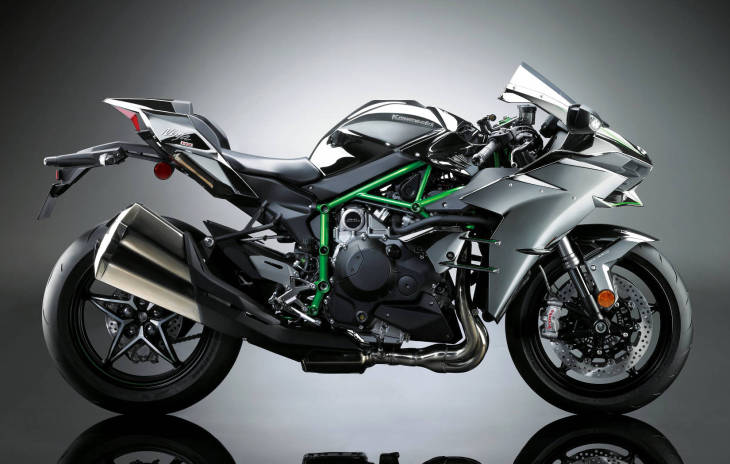
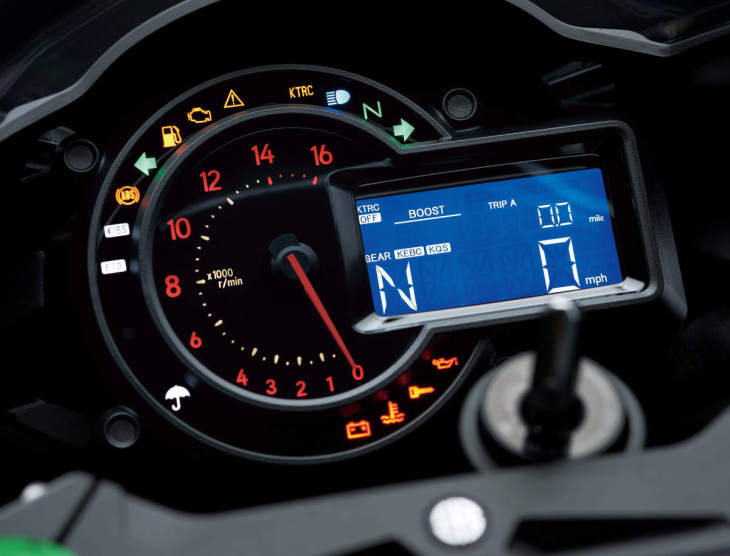
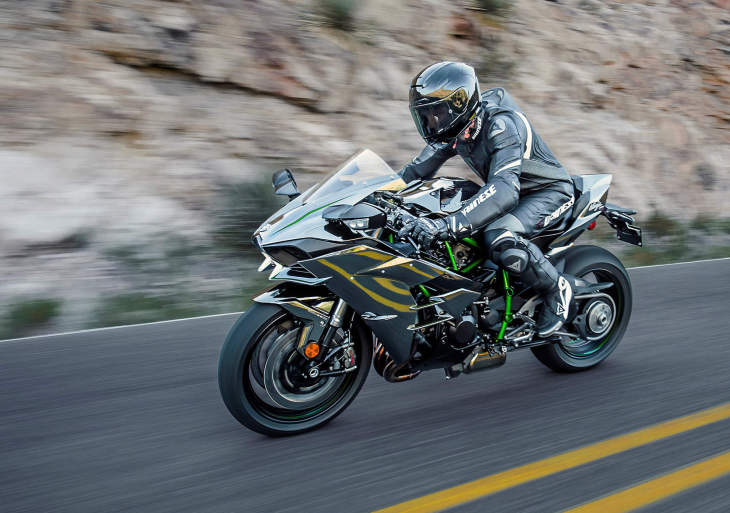
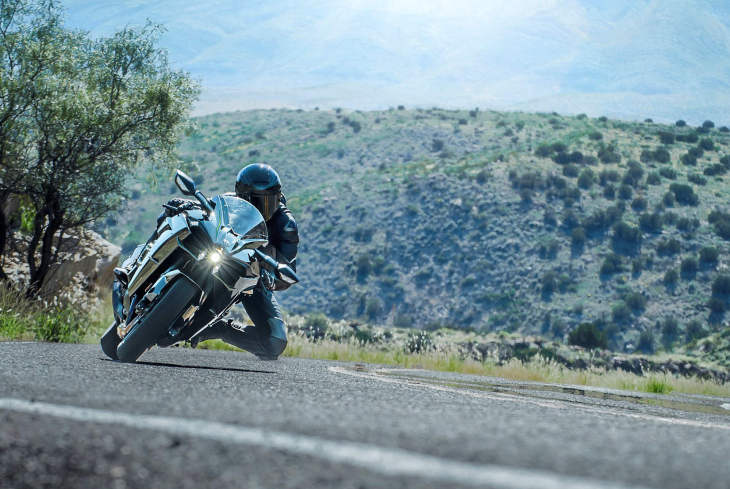

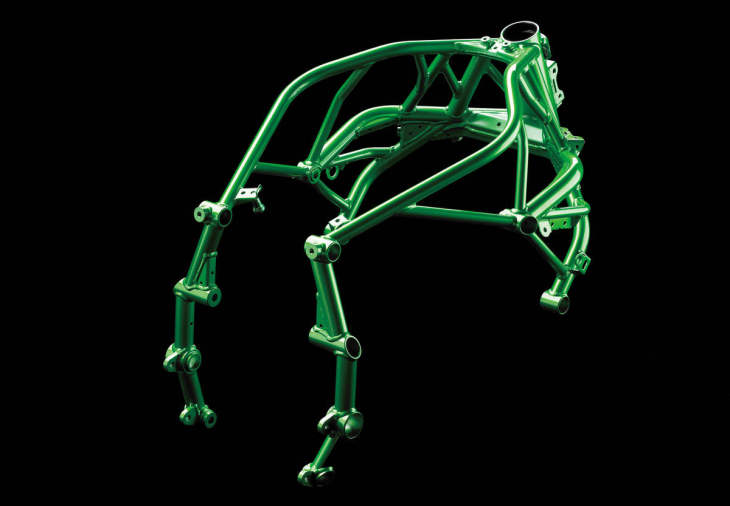
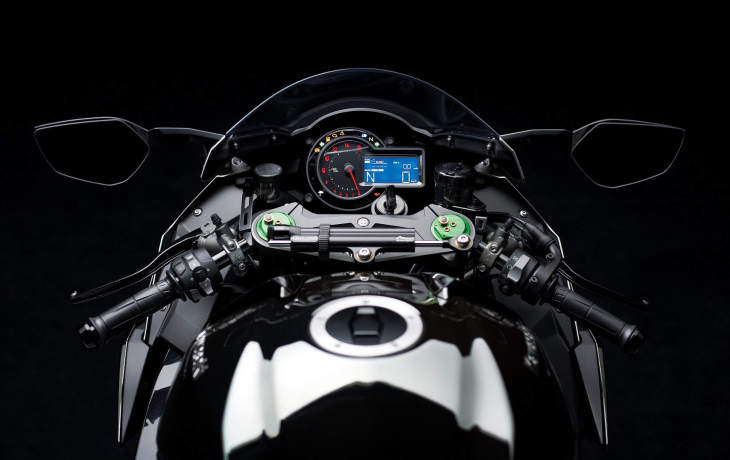
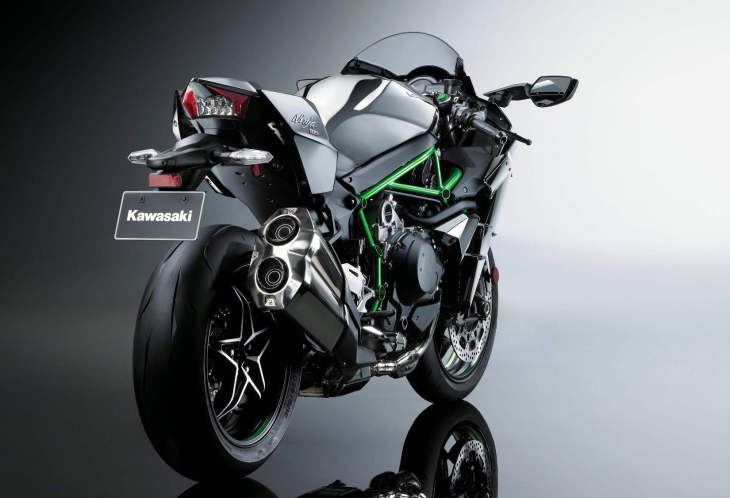

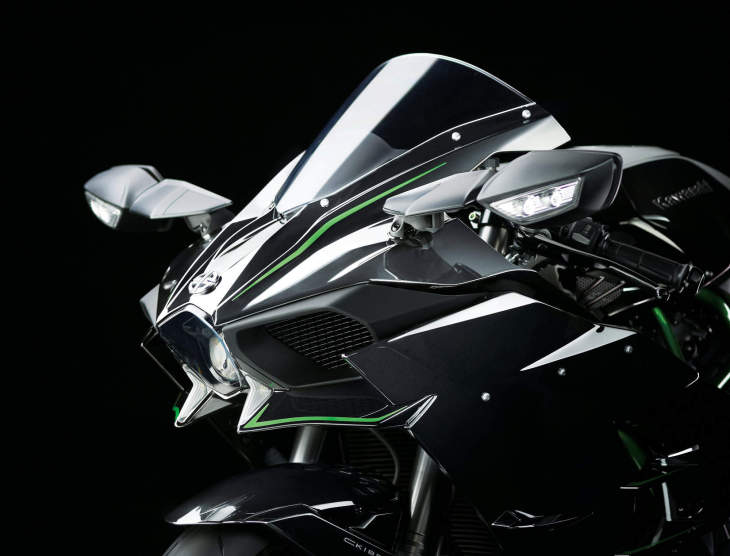

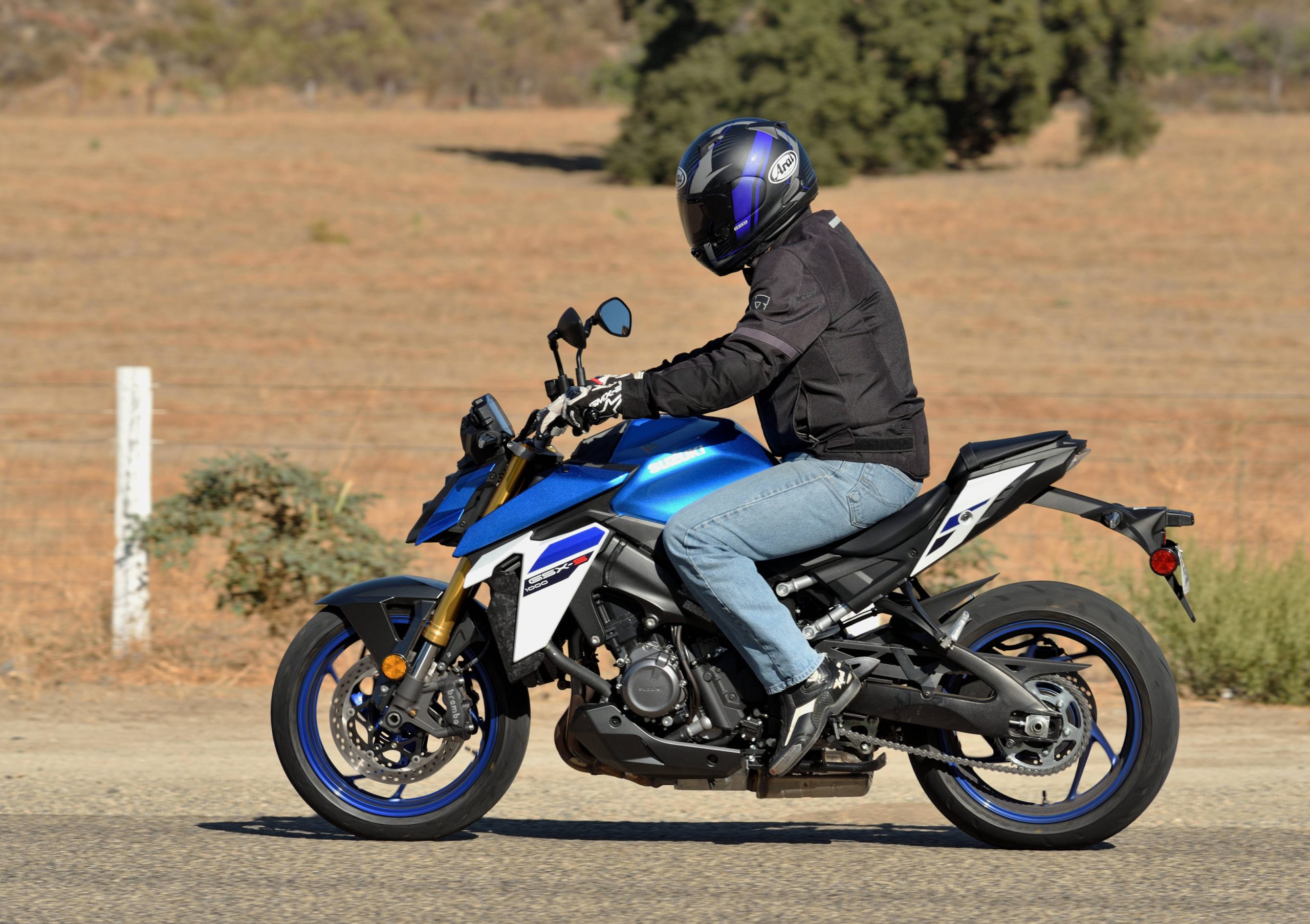
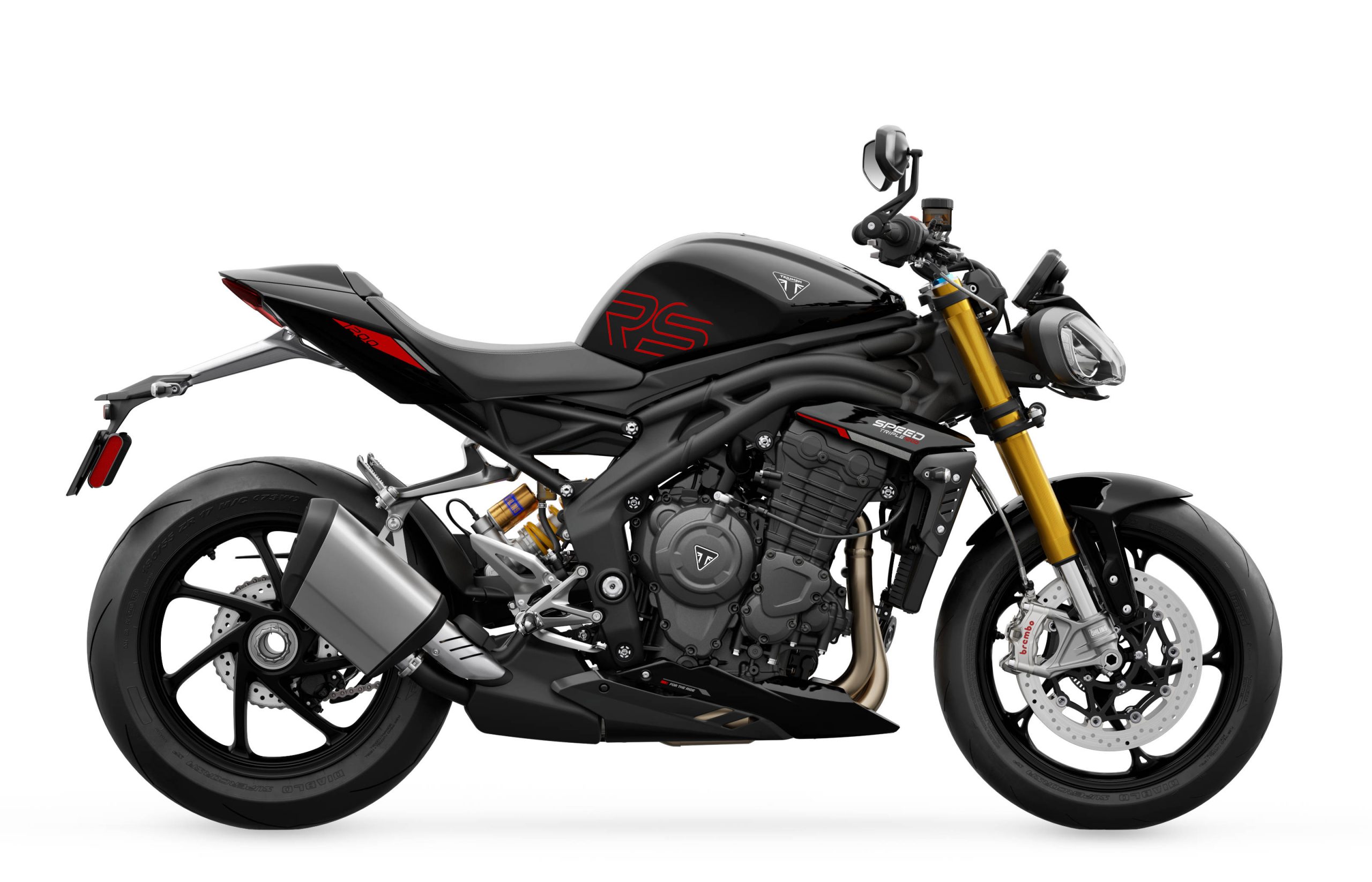
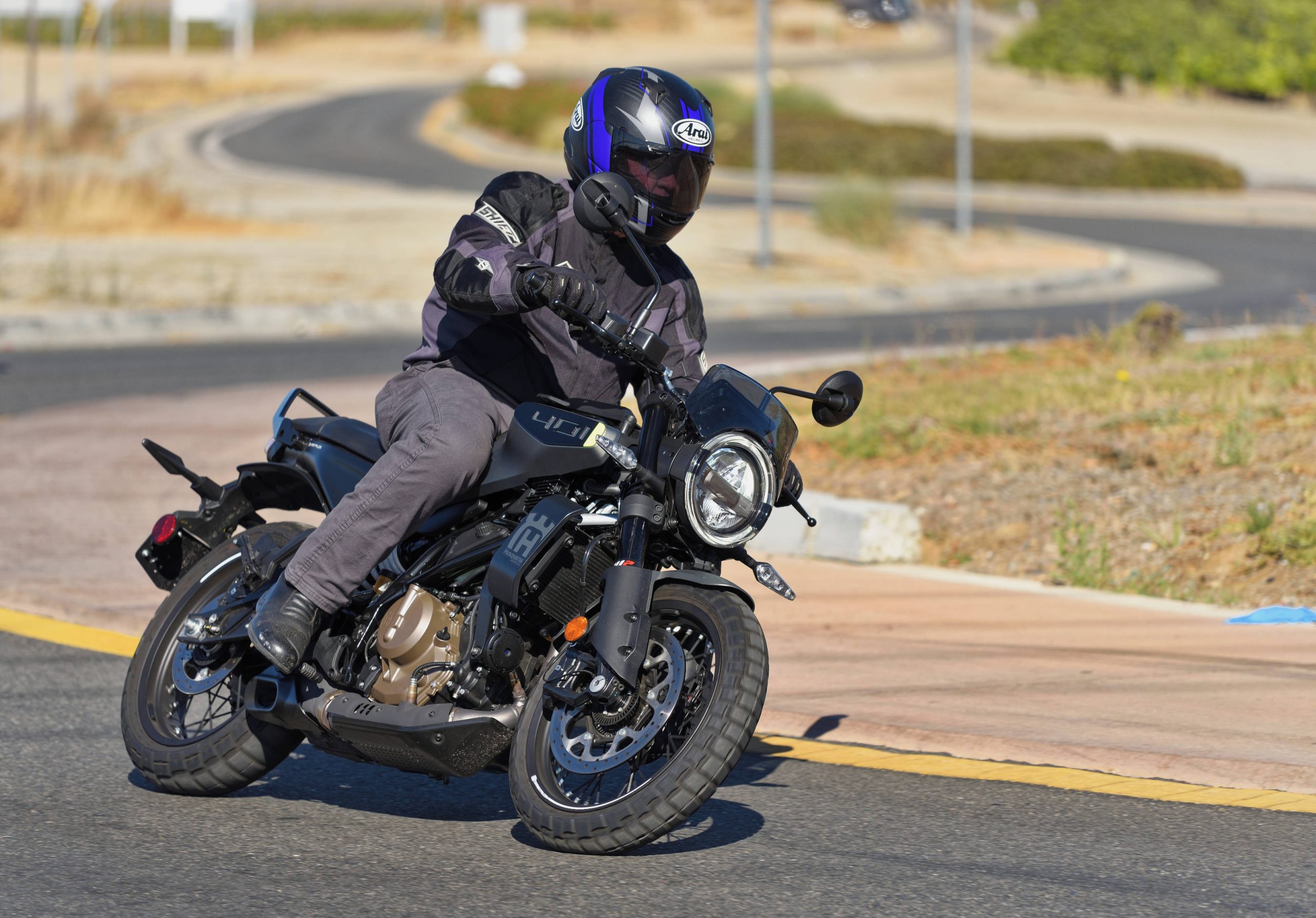
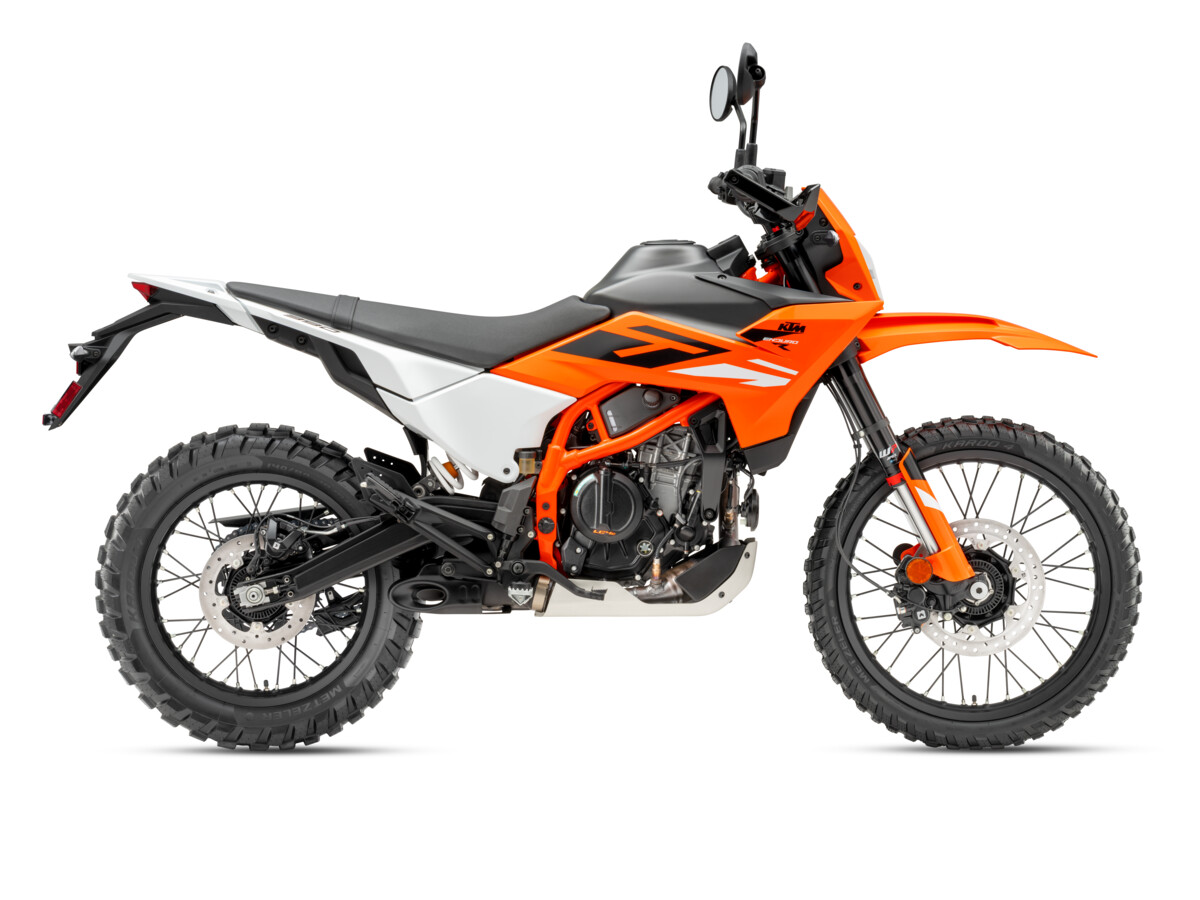
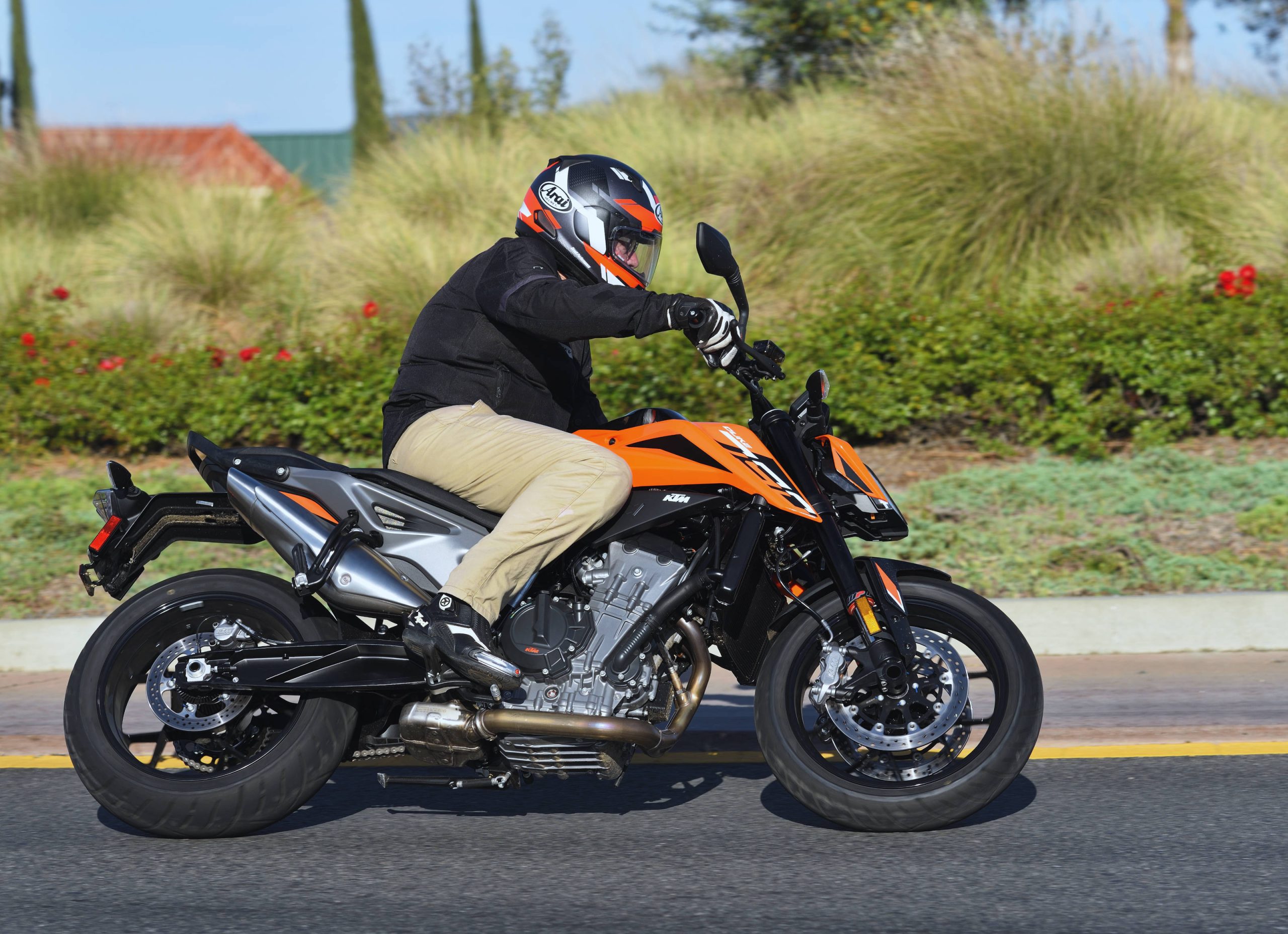
Funny how they can’t make a competitive Moto GP bike, or is this a distraction from that?
re: “fans of going fast inexpensively may be in for a little bit of a letdown: the H2 is $25,000”
“speed’s just a question of money, how fast can you go…?” – Max Rockatansky, Circa 1979
re: “fans of going fast inexpensively may be in for a little bit of a letdown: the H2 is $25,000″
Where else in performance vehicles can one acquire this kind of acceleration and speed for *only* $25k?
I guess the next issue to be dealt with should one fall victim to the siren call of this “beastie” is “Where the hell am I gonna be able to REALLY open the throttle on this thing”. I guess this question is really past tense given the multitude of license burners that have gone before it.
Lust is never a practical emotion …….
Since its limited I lost interest in it, before that was said I was obsessed. I wanted to buy it in the future
re: “Since its limited I lost interest in it”
don’t do that, this is the greatest motorcycle in the history of motorcycling. greater than even Honda’s V5 “shock and awe campaign”.
http://www.youtube.com/watch?v=yKGX4EQl9os
re: “I wanted to buy it in the future”
you still can…
stay thirsty my friend.
Yep this model does look a little “bitty” with a myriad of edges and aero surfaces however “elegant simplicity” is not the design theme here – technology IS – and every one of those edges and surfaces will be there for a considered reason.
I suspect this machine with it’s unique paintwork will be visually striking particularly in the right light conditions.
It is the torque this bike will make because of forced induction that will make this machine ungodly fast. Like most modern forced induction vehicles, you will probably get peak torque at a relatively low rpm and maintain that torque level through most of the powerband.
Roll on power in any gear any rpm will be totally insane with this bike.
Don’t get too focused on peak HP with this bike.
Looks like a two wheel Darth Vader. Organ donor card should be required to get one.
Seems like a good article on the H2 with hard numbers for power and torque. Where did 100 hp go?
http://www.mcnews.com.au/2015-kawasaki-ninja-h2/
It’s not just the horsepower here, consider how much torque this bike will have and how low in the rpm band you will get that big whallop of torque.
After market will have this bike well over 300 HP before you know it.
Not a bike that really interests me at all, but hats off to Kawasaki for building it.
Styling is certainly a departure from the same old, ubiquitous, GP-esque sportbike look we’ve been dealt for the past 35 years!
A refreshing departure at that.
Besides, if you make 225 hp ( I hope ) you can look any way you want. ( otherwise fugettaboutit !)
More serious compromises are weight (524 lbs ) and wheelbase. Looks 56 inch plus to me. Not exactly on par with leading edge corner-carving spec.
But then again competition is not it’s purpose.
Yup, reading would have been helpful.
57.3 inch wheelbase. That and launch control electronics; a little insurance against well-healed, over zealous squids reaching escape velocity too quickly without the exercise of proper throttle discretion and the certain destruction that follows.
I’m sorry. This has to be the ugliest machine ever. ever.
This origami thing has gone too far. Please. Stop. Now.
Ugh.
Give me the engine though.
Lots of everything here. Price, bling, weight (524lbs) and power.
I hope supercharging trickles down to 500cc bikes.
Indeed!
So when it breaks down do we take it to the dealership or Bestbuy/geeksquad to repair it??
How do 530 chains stand up to these 200HP and plus bikes? I recall hearing of old ZX9’s being able to snap chains on demand by crazies. If the chains are 25% stronger now the HP is higher yet. Guess you just have to add chains and sprockets along with tires as frequent replacement items. Pay to play.
Like the new MV’s they are not styled so much as a gigantic collection of shapes, mechanical in part and in part…………..I’m not sure what to call it. Functional?
Still think it shoulda been a 3 cylinder, 750, DI 2 stroke, with around 150 BPH and 400lbs fully fueled. They probably woulda sold boat loads of those.
+1
Well, since they are relying on their brother divisions for help, look no further than their marine engine manufacturer. 2 stroke turbo diesels are their specialty. Some downscaling required for motorcycle adaptation.
http://www.khi.co.jp/english/machinery/product/ship/2cycle.html
Wondering where the best place will be to see one actually being ridden. Guessing The Rock Store or some such place when Jay Leno shows up.
just got a text… Jay says meet you on Mulholland, bring your A-game. not sure what he’s eluding to…? but you’d better do he says.
http://m.youtube.com/watch?v=vAo0LWQFxdE
anyway, Bologna note comment @ 4:28.
those with devaluing mentalities (snake) note comment @ 7:35.
Another incredibly fast motorcycle, costing about twice as much as many other incredibly fast motorcycles. And Kawasaki seems not to want to sell them in large numbers. On the other hand the other divisions of Kawasaki Heavy Industries have picked up a lot of free advertising for their contributions to the H2.
Let the market forces begin.
Kawasaki and Yamaha have entered upper market (should we call it ‘luxury sport’?) where higher price being the norm for Ducati, BMW, and other European brands for a while now. I think it’s a smart move for Japanese manufacturers because there are many riders out there wanting pay premium. Most of these riders won’t take the bikes to race track. One of my friend riders bought a Ducati Panegale 1199 for $30k. Asking if he intends to take it to the racetrack, he says no and isn’t not shy acknowledging the fact that he just rides it for fun on the street. Anyway for the look I have to see it in person to judge but the new R1 or R1M really pleases eyes.
I don’t get the design language used. It has a myriad of design features going on, with seemingly none of them connected in any way. Some parts angular with others curved and swooping, oddly open fairings, misaligned creases and fins, and way too many small surfaces with out a recognizable form or design rules holding them all together. What a mess. And that horrible frame, why highlight it? Were they going for Industrial Messy Chic? They certainly nailed it…
“…way too many small surfaces with out a recognizable form or design rules holding them all together.”
Which design rules? The one’s dictating how to build the fastest production street motorcycle? Then again, I suppose there are more aesthetically pleasing ways of generating downforce or managing airflow. Maybe the engineers should have consulted with you on how to build an aesthetically pleasing Brinskee-approved version of go-fast parts.
I wish they would have. It would have looked a lot better than this disorganized eyesore!
Here’s the design language: http://www.google.com/search?q=samurai+shogun+warrior&biw=1280&bih=865&source=lnms&tbm=isch&sa=X&ei=MT5ZVP-WBcapNvmsgqgK&ved=0CAYQ_AUoAQ#tbm=isch&q=samurai+warrior&imgdii=_
Samurai warrior is the first thought I had when seeing the H2R from the front. I think it’s killer. Gets the message across that this machine means business.
See, but it’s not the design language. I agree, the area around the front cowl works, it’s the rest of the bike that falls apart visually. The Samurai suits have banded ridges and plates that are evenly placed and have a purposeful aesthetic. This bike… it’s rare that I think a bike is a mess and this one fits the bill. I like the engineering features! Just… the designer should be fired.
re: “It has a myriad of design features going on, with seemingly none of them connected in any way. Some parts angular with others curved and swooping, oddly open fairings, misaligned creases and fins, and way too many small surfaces with out a recognizable form or design rules holding them all together.”
brin, unveknownst
(norm note-3 stylus typing take 2)
brin, unbeknownst you’ve just stumbled upon the early algorithm for STEALTH.
Beauty is in the eye of the beholder. This beholder says ‘Fugly’.
I’m giving it the benefit of the doubt, as I do keep going back to look at it. The motorcycle equivalent of a “hot mess”, I would say, and that cant be a bad thing!
The word is… awesome .
(with accompanying wind howl)
Great Design, great engine, thumbs up for Ninja H2
Hats off Heavy K. That looks every bit of a $25K bike to me.
I’ve said it before, and I’ll say it again. This has been the most exciting couple of years for new products that I can remember.
Ditto!!
Look at the front of the bike and tell me it not a comeback design from the 1994 ZX-9R Ninja.
But i still want one !
This bike will be legend like the ZX-7 of the 90′
If you have to own only one bike in your live, it need to be a Ninja !
re: “Look at the front of the bike and tell me it not a comeback design from the 1994 ZX-9R Ninja.”
noticed that too huh…?
but it’s not ’94 B series. that shape is classic Zed9 D series. the last generation beginning in ’00 to whenever the first Zed10 arrived.
Maybe its looks will grow on me, but at the moment I think it looks like shite.
It better come to the table with at least 250 crankshaft HP or so, or I just don’t see the point. I mean, BMW’s latest S1000R is putting out about 200 HP at the crank, and that’s a 1000cc normally aspirated engine. It’s going to need all the power it can muster to justify its questionable looks and the extra complication of turbocharging.
re: “It better come to the table with at least 250 crankshaft HP”
oh you bet your a$$ pal…!
re: “BMW’s latest S1000R is putting out about 200 HP at the crank, and that’s a 1000cc normally aspirated engine.”
the BM’s not fit to hold the H2’s jockstrap. wait, did I say it right…? LOL
re: “the extra complication of turbocharging”
supercharging.
Other sites are reporting 207hp with ram air, 197 without. And 525 lbs wet. Seems like most people were expecting at least 225hp. I’m sure it’ll be a simple thing for owners to find the missing power, but still…after all the 300hp hype, this comes as a bit of a letdown.
That said: “Only 207 hp.” Ha!
pump your brakes kid, as evident by the River Mark, this bike’s a national treasure.(Sgt. Lincoln Osiris voice)
https://www.youtube.com/watch?v=hz5v_qAN1gk
lets just wait till this (and everybody else) roll across the dynos. I think you’ll find the numbers for “special K” as being understated. don’t want to draw to draw too much attention from the regulators and “johnny law” as this is production. the R’s closed course.
I think you’ll find the numbers for “special K” as being understated. don’t want to draw to draw too much attention from the regulators and “johnny law” as this is production. the R’s closed course.
you so much as LOOK at this thing wrong and she’ll spin the drum at 225.
Being supercharged it will make big power down low in the rev range. More than the BMW. More area under the curve.
I might want to try one at Bonneville, if I ever get there. Otherwise would not want to get on it. I ride pretty slow bikes mostly slow.
Wow; This is truly, a 21st century motorcycle.
Light weight compact engines are why automobile companies are so interested in acquiring motorcycle companies, perhaps we will see this type of power plant, in other vehicles.
The acronym race is heating up again.
OMG, that’s sooooo Buck Rogers… I love it…!!! LOL
LOL
ps, “I love it” was not necessarily my first reaction.
Probably not your first reaction on seeing the Bugatti Veyron either. That said, the motorcycle equivalent for a “mere” $25,000 will undoubtedly appeal to many.
re: “Probably not your first reaction on seeing the Bugatti Veyron either”
no, on that one the 4 turbochargers had me at “hello”.
This bike makes the Yamaha R1 much more tempting.
Bucket list… You could change the lyrics to “live like you were dying” to include this bike (I went 9 seconds on a bike named H2!)
I think they described it right, as being a Halo bike… When you already have two or three bikes to fill most of your needs, you can have this one to just go nuts! Come on, lottery ticket!
This bike is looking light a nightmare coming straight from a manga comic. The wheel base looks huge. This exhaust pipe….. Not a bike for a track day at all. What is the target market?
“What is the target market?”
Jay Leno
re: “This bike is looking light a nightmare coming straight from a manga comic”
Guillermo del Toro, Pacific Rim… JAEGERS.
Transformer are so 80’s.
I’d be sorely lying if I said I wasn’t impressed. VERY impressed.
But, a few dings:
1) The original H2 could be purchased by guys working at the Kool Aid factory in the early 70’s (don’t ask me how I know). I’d have to OWN the Kool Aid factory to justify 25 large for a bike, even one as capable as this. And, even if I could justify it, they aren’t interested in selling me one anyway, I don’t expect (in the Midwest) to ever see one on the road. So much for “coming off the dime” – exotic unobtanium the likes of Bugatti.
2) I had high hopes for an aesthetically acceptable exhaust after viewing the track-only bike. But I must have been high hoping it would actually happen. What do you think the bike’s pre-exhaust weight is – maybe 450 lbs.?
3) Having a wiener the size of a peach-tree trunk may, on paper, sound desirable to the average teenager, but what would he actually do with it in the real world? Same thing here. Bragging rights, I guess.
4) 20 psi boost? That’s not a typo? Norm, how do they get away with that burning gasoline? What’s the compression ratio?
I’m still impressed, though, gotta give credit where credit is due. It’s like motorcycling’s version of a NASA project.
That muffler would be the first thing to go.
Maybe they could have saved enough material from the muffler and built a real world bike that we all could afford and insure, and not be afraid to twist the throttle on. I’m sure this would tons of fun to try out, but really, who’s going to buy one, and use it at anywhere near it’s potential on the street? Most of the people (myself included) on this site couldn’t use a modern 600 to it’s full potential on the street. Yeah, I know you think you could, but in reality you’re just not that fast.
“built a real world bike that we all could afford and insure, and not be afraid to twist the throttle on.”
Your Ninja 300 awaits!
moderation? really?
he changed his name…! oh that’s friggin’ great…! (handclap)
down goes Fraser
Let the whining begin! Due to cheap guys not buying anything except old stuff, Kaw has decided to go “upmarket” and steal some of Ducati’s thunder. Can’t wait to see the prices on Honda’s RC213V street bike and the “serious” adventure bike. This is going to be fun.
re: “Kaw has decided to go “upmarket” and steal some of Ducati’s thunder.”
even stole their trellis, talk about “turning the knife”.
Bologna…? are you seeing this…?
Wow and wow:)
With a very trained and cautious throttle hand this bike would be a lot of fun–just make sure you are pointed in the right direction with nothing in front of you if you over do it!
Or, leave it on the ‘Valet parking’ setting that limits horsepower to 20 or so and speed to 25 mph.
Sam:)